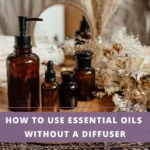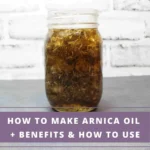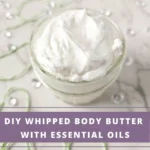As an Amazon Associate I earn from qualifying purchases. See Full Disclosure Here
As the days grow shorter and the air crisper, cultivating an autumn herb garden allows you to continue your gardening journey while savoring the unique flavors and scents of fall. The best herbs to plant in fall are those that can withstand cooler temperatures.
 While many might think that herb gardening is reserved solely for spring and summer, there are several herbs that not only tolerate but thrive in the crisp, cool air of autumn.
While many might think that herb gardening is reserved solely for spring and summer, there are several herbs that not only tolerate but thrive in the crisp, cool air of autumn.
Planting herbs that grow in fall is a delightful way to extend your gardening season and enhance your culinary experiences.
Along with the best herbs to plant in fall, you’ll find interesting details about the unique benefits of these herbs and quick tips on how to cultivate them.
The Neglected Potential of Fall Herb Planting
While spring may be the conventional time to plant your garden, fall often goes unnoticed as a great season for herb cultivation.
However, it’s a time brimming with potential and opportunities to create a garden that thrives even as the days grow shorter.
Fall herbs are hardy and resilient, capable of withstanding the challenges of the colder months and providing a bountiful harvest of flavors and aromas.
Top 10 Herbs To Plant In Fall
1. Rosemary: A Hardy Companion
With its woody evergreen nature, Rosemary (Rosmarinus officinalis) tops the list of fall herbs to plant.
It’ss a hardy herb that can withstand the challenges of fall and even survive in some winter climates. However, it is important to protect rosemary from freezing in colder areas.
This Mediterranean native prefers dry conditions and well-drained soil, making it a low-maintenance addition to your fall herb garden.
Rosemary is an attractive, drought-tolerant plant that needs at least 6 hours of sunlight during the day, so it does better outdoors
or on the patio, as opposed to growing it in your kitchen.
It can reach impressive heights of up to 6 feet, adding a touch of elegance to your garden. Propagating rosemary is relatively simple, allowing you to turn one plant into many.
Rosemary’s woody stems and needle-like leaves lend themselves well to hearty fall dishes, such as roasted meats and root vegetables.
Its leaves can be used fresh or dried, making it a convenient herb to have on hand throughout the year.
2. Sage: An Autumn Favorite
Its sturdy leaves and resilient nature make sage (Salvia officinalis) an excellent choice for a fall herb garden. This semi-woody perennial herb with its silvery leaves creates a stunning contrast against other plants.
If you’re looking for hardy herbs to plant in fall, you should definitely consider sage. This robust herb can survive various weather conditions, making it an ideal choice for fall planting.
One of the remarkable aspects of this herb is its ability to propagate easily. Sage is a perennial so it will keep returning year after year. Every spring, you want to prune the heavier stems to keep them healthy.
Starting the plant from transplants, seeds, or cuttings is relatively easy, and it thrives in sunny locations. Water it frequently when you first plant it, making sure it does not dry out.
As sage matures, it transforms into a semi-woody perennial, reaching heights of 12 to 18 inches. Its small, silvery leaves create a captivating backdrop for other plants, making it a versatile addition to your landscape beds.
The earthy flavor profile of sage pairs harmoniously with the autumnal palette of flavors. Its aromatic qualities are perfect for imparting warmth to soups, stews, and stuffings, all of which are staples during fall.
3. Parsley: Versatile and Beautiful
Parsley (Petroselinum crispum) is a versatile herb that comes in both curly and flat-leaf varieties.
This biennial herb thrives in cooler temperatures, earning it a spot among the top three herbs to plant in fall. Parsley is a cool-season plant that may start to fade as hot weather arrives.
Late fall or early winter is the perfect time to plant parsley, either from transplants or seeds. Soaking the seeds overnight before planting can help speed up germination.
An interesting aspect of parsley is its role as a host plant for caterpillars of the black swallowtail butterfly. Even if you don’t use parsley in your cooking, it can serve as a valuable resource for these beautiful creatures.
Parsley’s curly or flat leaves bring a burst of freshness to fall dishes, while also providing essential vitamins and minerals. Use it to garnish hearty stews, roasted vegetables, and even as a base for pesto.
4. Thyme: A Year-Round Herb
Thyme (Thymus vulgaris) is an herb that thrives in most seasons of the year, including the cooler months. Its delicate foliage with its gray-green leaves create a lovely sight in any herb garden or raised bed, especially in the fall.
This small, perennial shrub features tiny gray-green leaves that thrive in full sun and tolerate drought well. Thyme is one of those herbs that can be planted in late fall or early spring, provided it is grown in well-draining soil.
To harvest thyme, simply remove the top one-third portion of the plant when it is in full bloom and dry the leaves and flowering tops in a well-ventilated room. Store the harvest in tightly closed containers for future use.
Thyme is known for its quick growth, adding a touch of greenery to your fall garden.
The versatility and rich aroma of thyme shine through in both savory and sweet dishes. Whether you’re infusing thyme into casseroles or brewing a comforting cup of thyme tea, this herb’s presence enhances the cozy ambiance of the season.
5. Cilantro: Bright Flavors for Fall Dishes
For those seeking a burst of fresh, tangy flavors, cilantro (Coriandrum sativum) is an excellent choice for your fall herb garden.
Fun fact: Cilantro and coriander are derived from the same plant. The leaves are known as cilantro, while the seeds are called coriander.
Cilantro can be started from coriander seeds or transplants, and it thrives in areas with full sun to part shade and rich, well-drained soil. Crushing the seeds to break them open helps speed up germination.
While it’s known for thriving in cooler temperatures, cilantro may even be less prone to bolting in the fall, giving you more time to enjoy its zesty leaves in salsas, soups, and curries.
This bright green annual herb is a staple in Latin American and Southeast Asian cuisine. Cilantro’s bright, citrusy flavor adds a delightful twist to fall recipes.
6. Chives: A Gardener’s Delight
Chives (Allium schoenoprasum) is one of the best herbs to plant in fall if you’re a beginner gardener or have had limited success with other herbs. With minimal effort, you’ll be able to grow an abundance of chives that can be used in various culinary creations.
Chives thrive in milder climates and can be grown year-round as long as you plant them in a place that gets ample sunlight. These are not good herbs to grow indoors or on a shaded patio.
Their regrowth after winter brings the added bonus of gorgeous purple blossoms.
Chives come in clumps with up to 6 bulbs and need about a month to germinate from seed. To speed up the process, visit a local nursery to get your chives as young plants. As with all herbs, you want to keep it watered, adding more water when you notice the plant getting dry.
Their slender stalks can be snipped and added to salads, mashed potatoes, and creamy soups, infusing your autumn meals with freshness.
7. Calendula: Beauty and Function Combined
Calendula (Calendula officinalis) is a beautiful flowering herb that can add both visual appeal and practical function to your fall herb garden.
This easy-to-grow herb can be started from seed and its gorgeous flowers boast antioxidant and anti-inflammatory properties.
Calendula tea, made from dried leaves, offers a soothing drink for the winter months.
You can also make your own calendula infused oil which offers several benefits for the skin.
Additionally, calendula acts as a decoy, diverting aphids and caterpillars away from your precious fall salad greens.
8. Garlic: Not Just a Kitchen Staple
While technically not an herb, garlic (Allium sativum) is a kitchen staple that can be planted in the fall to enjoy a harvest in the spring or summer.
Garlic takes a longer time to grow. Planting it in the fall allows the plant to establish itself throughout the winter, resulting in a bountiful harvest.
Garlic is packed with powerful health benefits and is great to grow any time of the year including fall.
9. Chamomile: A Cozy Companion
With its daisy-like flowers and cottage garden feel, chamomile (Matricaria chamomilla) adds a touch of charm to any landscape.
The sense of coziness and tranquility that this flowering herb evokes makes it one of the best fall herbs to plant. It is a low-maintenance herb that easily self-seeds, ensuring its presence in future growing seasons.
Harvesting chamomile leaves in the fall allows you to brew your own cozy, packed-with-goodness chamomile tea during the winter months.
10, Winter Savory
True to its name, winter savory (Satureja Montana) is a hardy herb that thrives even as temperatures drop.
Its peppery, pine-like flavor adds a unique dimension to autumn dishes, such as bean soups, pot roasts, and grilled meats.
These 10 best herbs that grow in fall not only withstand the cooler temperatures but also enhance your culinary creations, ensuring that your garden remains a source of joy and sustenance throughout the changing seasons.
Tips for Starting Your Fall Herb Garden
Fall herb planting offers a world of possibilities and opportunities to create an enchanted garden that thrives even as the seasons change.
Know What You Can Grow
Knowing which are the best herbs to grow in fall is the key to having a thriving fall herb garden.
If you live in a mild climate, you will most likely be able to grow any herbs year-round.
However, if it gets cold where you are in the fall, then you want to be careful about the herbs you choose to plant. Some herbs that grow well in colder climates include mint, thyme, sage, lavender, parsley, cilantro, and chives. Keep in mind they might also be harvested in the winter, so if it gets too cold where you are, you may want to consider planting your herbs indoors.
Learn the Growing Habits of Different Herbs
Once you have a list of the herbs you want to plant, the next thing to do is read up on the best conditions for the herb to grow. This means knowing if it thrives better in direct or partial sunlight, the type of soil it needs, if it can grow indoors, and how much it should be watered.
Different herbs have different requirements, so make notes when planning out your fall garden.
For example, if you are growing parsley or cilantro, you should separate the plants by about a foot, while rosemary and sage need around 4 feet of space in between them.
Prepare for Growing
After gathering details about the herbs you want to plant, you can then start prepping the area. This is necessary whether planting seeds or starter plants.
You want to prepare your soil by loosening the soil where you are planting your herbs, adding compost and fertilizer, and having proper drainage in that area.
Watering and Harvesting
In general, herbs do not require too much water. They thrive in moist soil that drains well. Check on your plants and water them regularly but make sure not to water too much.
When harvesting, cut off only about 1/3 of the branches each time to promote healthy growth.
Recommended Resources to Start Your Fall Herb Garden
Here are a few resources you may find useful if this is your first attempt at growing a fall herb garden.
Living Whole Foods K5-1 Indoor Culinary Herb Garden Starter Kit
Rated “Top Pick” by Weekend Journal Section of the Wall Street Journal and winner of Editors Pick from Five Star Review Magazine, you can’t go wrong with the Living Whole Foods K5-1 Indoor Culinary Herb Garden Starter Kit.
The kit includes 12 culinary herb seeds with easy to follow instructions on how to set it up.
Nature’s Blossom Herb Garden Starter Kit
Nature’s Blossom Herb Garden Starter Kit is another highly rated kit on Amazon. This set includes everything you need to get started with your fall herb garden, from the seeds and planting pots to the peat soil and the plant markers. You get complete instructions for setting up and maintaining your fall garden.
Organic Gourmet Herb Collection
The list of fall herb gardening resources would not be complete without mentioning the Organic Gourmet Herb Collection by Stargazer Perennials. With this kit, you get four 3.5-inch containers with starter plants of thyme, sage, oregano, and rosemary.
Disclosure: This post contains affiliate links, which means if you click a link in this article and purchase something, I may make a small commission at absolutely NO cost to you. See Full Disclosure here









